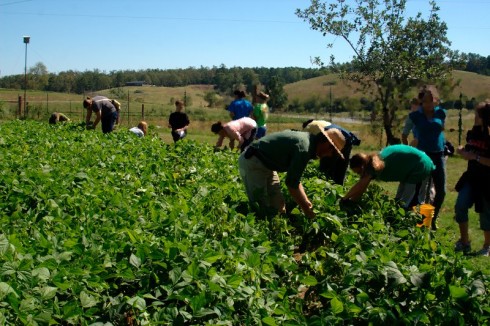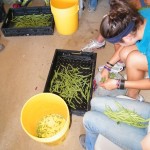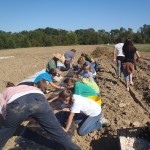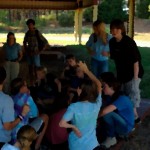
We worked in the fields this afternoon: picking beans and planting garlic. Clear skies with a cool, early October breeze; warm, but not hot.
It was enjoyable work. The fields were small and there were a lot of us. Lots of conversation.
We picked somewhere close to 64 lbs of green beans, which, according to our guide, sells for somewhere around six dollars per pound (organic beans). Three hundred and eighty four dollars. Took us about an hour.
Earlier in the morning, we’d had a discussion about Community Supported Agriculture (CSA). Heifer ranch is a CSA. People from the surrounding towns buy shares in the annual crop, and the ranch brings them a basket of produce every week for the season. CSA’s are great: fresh local produce, for about the same price as in the store. You tend to get a broad enough variety that it helps expand your cooking repertoire. And you avoid all the externailties from long distance transportation and factory farming.

They (our guides) had compared CSAs to the “typical” industrial agricultural system. Students read out notecards as they went through the all the jobs of the people who get your tomatoes to you. One student, who represented the energy going into the system, had to do a lot of jumping-jacks and pushups – situps too. There are eleven different jobs in the industrial system, with the people actually picking the crops – migrant workers – getting one cent for every dollar you pay at the store. They are three jobs within the CSA, and the farmer gets 80% of the sale price.
The presentation was a little problematic, unfortunately. Heifer is a CSA after all. Trouble started with our facilitator’s terminal question, “So which one do you think is better?” The first response was, “Well with the economy these days, won’t you loose a lot of jobs with the CSA?”
Fair point. But it might be argued that the industrial system might take one big farm and 11 jobs to bring 1200 tomatoes to market, it might take 4 CSAs, and about the same number of jobs (12), to do the same. Although the each person in the CSA system gets a little less, the money is more equitably distributed.
The second question, cut to the crux of the problem, “But what are the notecards leaving out?” Cynical? Perhaps. However, I’d like to think of it as healthy skepticism.
So now our guide was stuck. How could she, an obvious advocate for CSAs, convince the skeptical? Not easy, perhaps not even possible. By being too strong of an advocate for her side, she’d have a hard time convincing even the impartial.
It’s not easy making an argument that you’re passionate about. Not at all.

I made sure I had a small discussion with the more skeptical students, to make sure they realized that even if you distrust the credibility of someone, you can often learn something useful. In fact, that’s why you should always look for multiple sources of information. Also, while CSAs are great for some things, local farms in Arkansas or Missouri aren’t going to be producing a lot of tomatoes in January.
That’s why I’m glad we picked the beans later in the day. And it was important that we did the accounting.
It took sixteen of us one hour to pick $384 worth of beans. That works out to 24 bucks per person per hour. Since the migrant workers only make 1% of the final cost, we would have made about 24¢.
24¢ for an enjoyable hour of gardening on a pleasant day. But what do you do when you’re hot and miserable in the middle of the summer, and hour after hour after hour of the same work is what you need to feed your family. And you’re missing school to do it.

I’m not sure that students will intuit the difference between what we did and what migrant farm workers do; neither the time we put in, nor the effort we expended were anywhere near equivalent.
I think making that distinction is important. Recognizing what migrant workers do, many who are the same age as my students, might make the point of what organizations like Heifer and Human Rights Watch are trying to do better than just talking about it, or simulating it, in the classroom.
I think it might make a big difference to hear the voices of these workers.
So I’ll show the HRW video advocating for the CARE Act to reduce child labor among teen migrant workers, and see if it has an impact.







